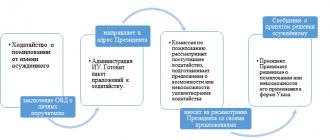The Plenum of the Supreme Court updated clarifications on the practice of considering criminal cases and issues of parole
On October 28, the Plenum of the Supreme Court adopted the Resolution “On Amendments to Certain Resolutions of the Plenum of the Supreme Court of the Russian Federation on Criminal Cases.”
Thus, the Resolution of April 21, 2009 No. 8 “On the judicial practice of parole from serving a sentence, replacing the unserved part of the sentence with a more lenient type of punishment” was amended, according to which the courts should apply the rules provided for in Part 3.1 of Art. 79 of the Criminal Code, when deciding on parole from serving a sentence or replacing the unserved part of the sentence with a more lenient form, if a person is convicted of a set of crimes of varying severity or a set of sentences.
List of diseases that prevent serving a sentence
APPROVED by Decree of the Government of the Russian Federation dated February 6, 2004 No. 54 (as amended by Decree of the Government of the Russian Federation dated May 19, 2021 No. 598)
List of diseases that prevent serving a sentence
| Name of diseases | ICD-10 code | |
| I. Infectious diseases | ||
| 1. | Tuberculosis of the respiratory system, a chronic course, the cure of which cannot be achieved by any methods (consisting in group II B of dispensary observation), with the development of respiratory failure of the third degree | A15.0-A15.9 |
| 2. | Progressive destructive tuberculosis of the spine, large bones and joints with persistent dysfunction | A18.0 |
| 3. | Renal tuberculosis with the development of chronic renal failure in the terminal stage | A18.1 |
| 4. | Tuberculosis of the abdominal organs with total damage to the visceral and parietal peritoneum, with adhesions and intestinal obstruction with symptoms of cachexia | A18.3 |
| 5. | Tuberculosis of the meninges and central nervous system | A17.0; A17.8 |
| 6. | Neurosyphilis | A52.1; A52.3 |
| 7. | The disease caused by the human immunodeficiency virus, in the stage of secondary diseases 4B in the progression phase and the terminal stage | B20-B24 |
| II. Neoplasms | ||
| 8. | Various forms of malignant neoplasms, regardless of their location, in the presence of a locally advanced tumor that compresses surrounding organs and structures or grows into surrounding organs and structures that are not subject to radical treatment, or in the presence of distant metastases (disseminated process). The diagnosis must be confirmed by morphological examination of the tumor or metastatic lesion. Morphological confirmation of the diagnosis is not necessary for intracranial tumor localization if the diagnosis was established on the basis of clinical and instrumental research methods. All cases of malignant neoplasms requiring treatment in a specialized medical organization (surgery, radiation therapy, chemotherapy), which cannot be carried out at the place of serving the sentence | S00-S97 |
| 9. | Space-occupying formations of the brain and spinal cord | D33; D43 |
| 10. | Lymphangioleiomyomatosis of the lungs with respiratory failure stage III | D48.1 |
| III. Blood diseases | ||
| 11. | Aplastic anemia | D61 |
| 12. | Agranulocytosis | D70 |
| IV. Endocrine system diseases | ||
| 13. | Diabetes mellitus, severe form, with multiple complications | E10.7; E11.7 |
| 14. | Diabetes mellitus, severe form, with diabetic preproliferative or proliferative retinopathy | E10.3; E11.3 |
| 15. | Diabetes mellitus, severe form, with ketoacidosis | E10.1; E11.1 |
| 16. | Diabetes mellitus, severe form, with the development of chronic renal failure in the terminal stage of kidney damage or chronic renal failure, in which there are indications for starting dialysis treatment | E10.2; E11.2 |
| 17. | Diabetes mellitus, severe form, with widespread severe polyneuropathy | E10.4; E11.4 |
| 18. | Diabetes mellitus, severe form, with severe angiopathy | E10.5; E11.5 |
| 19. | Chronic adrenal insufficiency, severe form | E27.1; E27.4 |
| 20. | Diabetes insipidus, severe form | E23.2 |
| 21. | Hyperparathyroidism, severe form with renal failure | E21.0-E21.5 |
| 22. | Itsenko-Cushing syndrome, severe form | E24.0-E24.9 |
| 23. | Pituitary insufficiency (Simmonds disease) in the cachexia stage | E23.0 |
| 24. | Hyperfunction of the pituitary gland with irreversible visual impairment, severe neurological and mental disorders | E22.0-E22.9 |
| 25. | Thyrotoxicosis, severe form (if surgical correction is not possible) | E05.0-E05.9 |
| 26. | Cystic fibrosis with pulmonary manifestations and stage III respiratory failure | E84.0 |
| V. Mental disorders | ||
| 27. | Chronic and protracted mental disorder with severe persistent or often exacerbating painful manifestations that do not allow the patient to realize the actual nature and social danger of his actions (inaction) or to manage them | F01; F06; F20-F22; F73 |
| VI. Nervous system diseases | ||
| 28. | Demyelinating diseases of the central nervous system | G35-G37 |
| 29. | Polyneuropathy | G60-G62; G64 |
| 30. | Systemic atrophies affecting primarily the central nervous system | G10-G12 |
| 31. | Parkinson's disease with severe akinetic-rigid syndrome | G20-G21 |
| 32. | Torsion dystonia, generalized form | G24.1; G24.2 |
| 33. | Other extrapyramidal diseases with severe movement disorders | G25 |
| 34. | Syringomyelia | G95.0 |
| 35. | Vascular and vertebrogenic myelopathy | G95.1; G95.9 |
| 36. | Diseases of the neuromuscular junction and muscles (myasthenia gravis, myopathy) | G70-G72 |
| 37. | Toxic encephalopathy | G92 |
| VII. Eye diseases | ||
| 38. | Complete blindness | H54.0 |
| 39. | Marked decrease in visual acuity due to persistent pathological changes (visual acuity of the eye that sees better does not exceed 0.05 and cannot be corrected) | H54.2 |
| 40. | Severe concentric narrowing of the visual fields of both eyes (10 degrees or less) | H53.4 |
| VIII. Diseases of the circulatory system | ||
| 41. | Acquired heart valve diseases, accompanied by chronic heart failure stage III according to Obraztsov-Strazhesko-Lang/IV functional class according to NYHA and (or) persistent disturbances of cardiac rhythm and conduction: recurrent ventricular tachycardia, paroxysmal and persistent tachysystolic fibrillation and atrial flutter, not amenable to medication control and surgical correction | I05-I09; I34-I38 |
| 42. | Hypertension, secondary arterial hypertension, accompanied by chronic heart failure stage III according to Obraztsov-Strazhesko-Lang/functional class IV according to NYHA and (or) persistent cardiac conduction rhythm disturbances: recurrent ventricular tachycardia; paroxysmal persistent tachysystolic fibrillation and atrial flutter, not amenable to drug control and surgical correction and (or) with the development of chronic renal failure in the terminal stage of kidney damage or chronic renal failure, which requires dialysis | I10-I15 |
| 43. | Severe forms of ischemic heart disease (including angina at rest), not subject to surgical correction, accompanied by chronic heart failure of stage III severity according to Obraztsov-Strazhesko-Lang/IV functional class according to NYHA and (or) persistent disturbances of cardiac rhythm and conduction : recurrent ventricular tachycardia; paroxysmal persistent tachysystolic fibrillation and atrial flutter, not amenable to drug control | I20-I25 |
| 44. | Cardiomyopathies (dilated, hypertrophic, restrictive, arrhythmogenic cardiomyopathy of the right ventricle), accompanied by persistent disturbances of heart rhythm and conduction, refractory to therapy, the presence of chronic heart failure stage III according to Obraztsov-Strazhesko-Lang/IV functional class according to NYHA, with repeated thromboembolic complications and (or) chronic thromboembolic pulmonary hypertension of functional class IV | I42.0-I42.9 |
| 45. | Chronic pericarditis, not subject to surgical correction, with the presence of chronic heart failure stage III according to Obraztsov-Strazhesko-Lang/IV functional class according to NYHA and (or) accompanied by persistent severe disturbances of heart rhythm and conduction, refractory to therapy | I31.0-I31.1 |
| 46. | Idiopathic (primary) pulmonary hypertension, kyphoscoliotic heart disease, chronic thromboembolic pulmonary hypertension and other specified diseases of the pulmonary vessels, with the presence of chronic heart failure stage III according to Obraztsov-Strazhesko-Lang/IV functional class according to NYHA and (or) accompanied by persistent heart rhythm disturbances and conductivity | I27.0-I27.2; I27.8; I28.8 |
| 47. | Cerebrovascular diseases with severe persistent symptoms of focal brain damage (hemiplegia or paraplegia, deep hemiparesis or paraparesis) | I60-I67; I69 |
| 48. | Damage to the main and peripheral arteries, leading to the development of gangrenous-necrotic and infectious complications that are not amenable to systemic and local treatment | I70-I78 |
| IX. Respiratory diseases | ||
| 49. | Chronic nonspecific lung diseases with diffuse pneumosclerosis, pulmonary emphysema, chronic pulmonary heart disease in the stage of decompensation, chronic respiratory failure of the third degree | J43; J44.8; J45.0; J45.1; J45.8; J47; J60-J70; J82; J84 |
| 50. | Diseases of the diaphragm with respiratory failure stage III | J98.6 |
| X. Diseases of the digestive system | ||
| 51. | Intestinal diseases in the stage of cachexia with severe malabsorption and digestion syndrome | K50.0-K51.9; K90.0-K90.9 |
| 52. | Decompensated liver cirrhosis of various etiologies (ascites, severe portal hypertension and hepatic encephalopathy (class C according to the Child-Pugh classification) | K74.3-K74.6 |
| XI. Diseases of the genitourinary system | ||
| 53. | Diseases of the kidneys and urinary tract with chronic renal failure in the terminal stage or in a stage requiring regular extracorporeal detoxification | N00-N99 |
| XII. Diseases of the musculoskeletal system | ||
| 54. | Severe congenital, acquired, systemic, dysplastic, dystrophic and degenerative diseases of the musculoskeletal system with severe functional disorders of the musculoskeletal system, severely impairing self-care and requiring constant assistance | M00-M99 |
| XIII. Congenital malformations | ||
| 55. | Congenital malformations of the circulatory system | Q20-Q28 |
| XIV. Injuries and other consequences of external causes | ||
| 56. | Injuries of the central nervous system with severe persistent symptoms of focal brain damage (hemiplegia or paraplegia, deep hemiparesis or paraparesis) | S06.2-S06.9; S14.1; S24.1; S34.1 |
| 57. | Acute and chronic radiation sickness of extremely severe degree, local radiation injuries (radiation burns) of severe and extremely severe degree | |
Commentary to Art. 81 Labor Code of the Russian Federation
1. The grounds for dismissing an employee at the initiative of the employer may be applicable both to all categories of employees and to certain categories of them, taking into account the content of their employment contract.
2. The Labor Code and other federal laws may provide for additional grounds for termination of an employment contract at the initiative of the employer (see commentary to Articles 278, 336 of the Labor Code).
3. All grounds for termination of an employment contract at the initiative of the employer can be divided into three groups related to:
1) production circumstances;
2) personal circumstances of the employee;
3) guilty behavior of the employee.
4. When terminating an employment contract at the initiative of the employer, it is necessary to comply with the conditions established by law and the procedure for dismissal for each of the grounds, with the provision of additional guarantees for certain categories of employees (see commentary to Articles 261, 269, 373, 405 of the Labor Code, etc.) , as well as compensation upon dismissal (see commentary to Articles 178 - 181 of the Labor Code).
5. In case of dismissal of an employee due to production circumstances (liquidation of an organization or termination of activities by an individual entrepreneur, reduction in the number or staff of employees, change of owner of the organization’s property, etc.), it is also necessary to keep in mind the relevant provisions of the Civil Code that determine the procedure for creation, transformation and liquidation legal entities.
6. Termination of an employment contract due to the employee’s personal circumstances (for example, inadequacy for the position held or work performed due to insufficient qualifications confirmed by certification results) is associated with the inability to perform job duties for reasons beyond his control. Therefore, the employer’s provision of evidence confirming these circumstances is of particular importance.
7. When dismissing an employee for culpable reasons (one-time gross violation or repeated failure to perform job duties without good reason, absenteeism, state of alcohol, drug or other toxic intoxication, theft of someone else’s property at the place of work, etc.), it is necessary to comply with the procedure and terms for attracting the employee to responsibility for the offenses he has committed (see commentary to Chapters 30 and 43, Section XI of the Labor Code).
8. In the event of a dispute regarding the reinstatement of a person whose employment contract was terminated at the initiative of the employer, the obligation to prove the existence of a legal basis for dismissal and compliance with the established procedure for dismissal rests with the employer (see clause 23 of the RF PPVS dated March 17, 2004 N 2).







